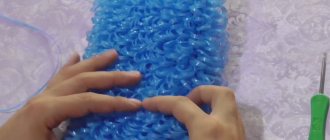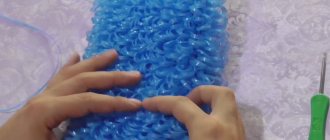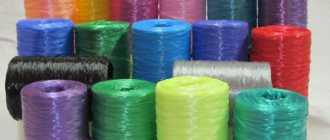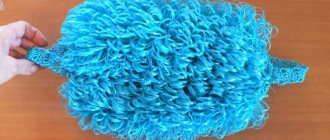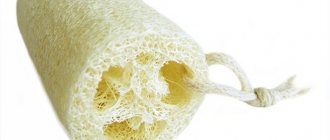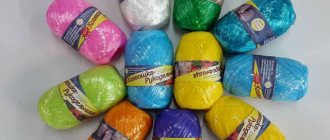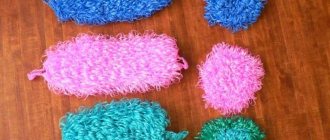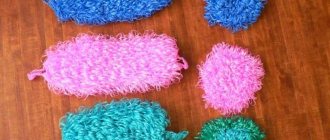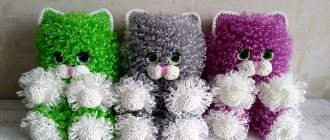To make the process of washing in a shower or bath useful and enjoyable, it is necessary to ensure the availability of several, preferably different in quality and functional purpose, washcloths. The stores are filled with various bath products; there are also a wide assortment of washcloths on the shelves. But if you enjoy handicrafts such as knitting, and you know a lot about it, then you can easily knit any model yourself.
The main function of washcloths is to cleanse and remove dead cells from the top layer of skin. For this reason, the yarn for making a washcloth should be moderately stiff in order to effectively remove the top layer of the epidermis and provide a high-quality body massage. If you decide to knit washcloths yourself, then choose raw materials from those listed below.
How to choose threads
The best yarn for washcloths is single- or double-twisted polypropylene, but threads that are natural in composition are even more valued. The yarn should be strong and smooth. The thicker the thread, the stronger the product.
- Jute. Eco-friendly washcloths are knitted from it. Jute yarn is made from the fibers of an annual plant grown in India and Egypt. A jute washcloth is moderately hard, it absorbs water well and lathers up. Daily exposure of jute to the skin stimulates blood circulation and improves metabolic processes in the dermis.
- Hemp. Yarn made from hemp stem fibers. Its properties are similar to flax, but at the same time more durable and lighter. Products made from it do not lose their shape and do not stretch when exposed to moisture.
- Lyko. It is made from linden or willow wood fibers. These washcloths are suitable for sensitive skin.
- Loofah. Yarn made from grass fibers. Its effect on the skin is difficult to overestimate: pore cleansing, anti-cellulite massage, cell regeneration. At the same time, such a washcloth turns out to be very tough. The loofah holds its shape well, quickly soaks in water and lathers well.
- Sisal. Agave fiber. Like any natural yarn, it has a beneficial effect on the condition of the skin, but due to its increased rigidity, it is recommended to use this accessory no more than twice a week. The disadvantage of sisal is that it takes a long time to dry.
- Linen. The most delicate material, suitable for baby washcloths, but before use, such an accessory must be steamed with hot water.
- Cotton. Most often it is used for washcloths for babies. Such products are short-lived, but cotton is best suited for children's skin.
- Capron. Such threads are usually thin, so they are knitted in several layers. The products are durable, but tend to stretch.
- Polyethylene. For knitting, it is better to use industrially produced yarn, but experienced craftswomen can also indulge in creativity using homemade “threads” from ordinary plastic bags. The advantage of such washcloths is moderate rigidity and durability. The downside is poor absorption and the possibility of skin allergies.
Technology of processing bast to obtain bast
Back in the mid-1980s, markets and hardware stores in the USSR had thick paint brushes made of wood fiber, which housewives of that time used to whitewash tree trunks and borders with lime. During communist subbotniks, they were sometimes given out as tools of production, as a result of which they were safely transferred from the national economy to the private economy.
The main technological methods can be distinguished as follows:
- Linden can produce raw materials from both mature and young trees.
- The main harvesting period falls on the period from the Annunciation to Trinity.
- The bark is removed from young trees through longitudinal cuts no more than 100 cm long, in an amount of no more than 4 per trunk. Large trees are debarked on both sides, and the bark is removed using tines - wooden wedges that are driven between the subbark and the tree trunk itself. The separated parts are removed in the form of two gutters.
- A very important part of the preparatory work is soaking. It is carried out in a shallow, up to 0.5 m reservoir with a hard, flat bottom and running water. As a result, the fibers acquire the necessary qualities, primarily plasticity, and are easily separated from the supporting substrate. The duration of the procedure is a very uncertain indicator and directly depends on the specific growing conditions and quality of the material. In practice, in most cases, it can range from 2 to 7 weeks. Soaking can be avoided if the work is carried out on very young trees whose subbark has not hardened sufficiently.
- After soaking, the fiber is removed, distributed and cleaned by combing with a primitive comb.
- Next, drying begins under a canopy with good air flow and constant monitoring of the raw materials, since, like any organic material with a sufficient level of humidity, it is susceptible to rotting.
A word from Experienced! After drying, the traditional technology involved “gilding”, that is, the bast bundles were exposed to direct sun, as a result of which the surface was covered with a rich straw-golden color. Let's face it, this finishing procedure is more typical for the production of bast shoes than washcloths, since exposure to ultraviolet radiation makes the bast harder.
Washcloths were made from ready-made raw materials using a primitive twisting method, when a layer of material approximately 80 - 100 mm thick is intercepted with a rope in two places and pulled together to maintain its shape. In this context, the more correct expression is not how to weave washcloths, but how to knit them.
You can see the manufacturing process visually and more clearly in the attached video.
Remember! The service life of such a washcloth rarely exceeds 5 - 8 procedures and it is susceptible to damage by microorganisms, which is quite natural for a natural product.
Correctly deciding how to weave a washcloth for a bath is not everything; what is important is how to use it correctly. Before use, such a product must first be steamed for 5 - 7 minutes in moderately hot water, and then rinsed thoroughly in cool water.
Flat washcloth
Beginners should learn lessons on knitting flat washcloths.
To do this you will need a small skein of yarn (about 300 m) and a hook. To start working, you need to dial 30 air loops (VP). There may be more loops, depending on the diameter of the washcloth you want to get. Connect the cast-on chain into a ring, make 1 VP rise and knit two rows with single crochets (SC) in each loop. The third row is knitted with double crochets (C1H). To do this, make 3 VP lifts at the junction point, and then go through a complete circle.
Next the main fabric is knitted. Cast on 3 VP lifts and knit two C1H between the columns of the previous row. Then skip two stitches of the previous row and knit three C1H between the second and third. In increments of two columns, knit to the end of the row. The last stitch to make is the connecting post for the first loop of this row.
The next row begins with three instep stitches, and then between the triple stitches of the previous circle, three C1H are again knitted. Continue knitting in this way until the end of the product. The length of the washcloth is selected individually.
At the end of the work, the rows that were before the main pattern are repeated in reverse order. First, a row is knitted, where two S1Hs are made between the triple stitches of the previous circle, and then one VP lifting loop is made and two rows of RLS are passed. The last loop is tightened and cut.
For handles, dial 5 VP. 2 C1H are knitted into the last and penultimate VP. Next, lift 3 VPs and turn the work. Between the columns of the previous row, knit two C1H. Continue knitting in this way until the selected handle length is reached.
Using the RLS, secure the handle to the washcloth.
Video lesson:
Double crochet washcloth
The product is knitted in the round and has two layers. Using double crochets allows you to knit a washcloth twice as quickly and at the same time reduce thread consumption. The washcloth turns out to be soft, gentle, and quite comfortable to wash with. Threads to create the product were used in two colors, since the product is made with a gradient.
We knit with two threads using crochet number 5. 35 air loops are cast on and closed with a ring. The next row is knitted with single crochets. Then the elongated loops are knitted with a double crochet. To make the loops elongated, they are formed using the thumb. The stitches knit together very quickly. Subsequent rows are knitted similarly.
With extended loops
Even a beginner can master the description of crocheting this most popular washcloth. This accessory is suitable for both adults and children, because the “shaggy” loops make the washcloth moderately soft.
Typically, polypropylene threads are used for such products, but it is difficult for beginners to work with them, so it is better to learn how to pull out loops using regular cotton or linen. In knitting itself, there should be no difficulties: for the washcloth, cast on the same 30 loops and knit two rows of sc, then two rows of dc, and in the next two rows work according to the pattern. Then alternate: one row C1H and two rows according to the pattern.
By alternating threads, you can make a bright washcloth.
A little history and purpose
It is not known for certain when the first devices appeared to help cleanse the skin, but already in references in Babylon and Ancient Greece there is information about the first washcloths. Wealthy people used wood or bronze to wash their skin, while poor people used bunches of plants or sand.
Now, a washcloth is already an absolutely necessary household item for every person. Beautifully designed, of different sizes, colors and purposes, they decorate the bathroom and are indispensable assistants in the bathroom.
A washcloth can be made from any available material: natural cotton or chintz, using old terry towels, woven from burlap, and for those who are not looking for easy ways - knitted.
Single layer washcloth
The method of elongated loops can also be used when knitting single-layer washcloths, which will have terry on both sides. To do this you will need a hook (3-5 mm depending on the thickness of the threads) and yarn.
First you need to dial 16 VP and 2 VP lifting loops. Then insert the hook into the fourth loop from the beginning and knit a sc. At the end of the row, make 1 ch and turn the work. The next row is knitted with C1H, in total there will be 16 such stitches. The first time the hook is inserted after the second column of the previous row. The last ones to knit are two sc in one cell. Then 1 VP and the work is turned.
The third row is with elongated loops. Pull the working thread onto the thumb of your left hand, insert the hook between the second and third stitch of the previous row and knit a sc, securing the elongated loop. Similarly, continue to knit between the columns of the previous row. There will be 14 elongated loops in the row. In the last cell, knit 1 sc, and then 1 VP rise and turn the work.
The new row is knitted similarly to the previous one with elongated loops. Continue knitting to the required height. Finally, the series C1H is performed. To do this, first dial 3 VP lifts and then follow the pattern, not forgetting to knit 2 C1H into the last cell.
Moving on to the handles. Cast on 3 VP lifting loops and turn the work. Then - 1 C1H between the first and second columns and another 1 C1H between the next columns of the previous row. Next, go up 3 VPs, turn the work and continue knitting in the same way. The handle requires approximately 20 rows, after which it is attached to the base using RLS.
To make the product neat, tie a washcloth around the edge of the RLS.
From plastic bags
A large selection of multi-colored plastic bags, different in texture, is used for knitting washcloths. You can take already used ones, or you can buy new ones. It is better to choose softer ones that do not have handles or ties.
You can choose any shape of washcloths. The main thing is to properly prepare yarn from them.
| The bag must be folded several times to one side, leaving approximately 2.5 cm. | |
| The folded part of the package is cut into strips 2.5-3 cm wide, not cutting completely. | |
| The strips are straightened in length. | |
| Then the uncut part is straightened out and the strips are cut diagonally. The cuts go from the cut of the 1st strip to the 2nd, from the cut of the 2nd strip to the 3rd and so on. | |
| It should turn out like this. | |
| The arrow shows the seam of the bag. |
Next, the strips are wound into balls and you can start working. For a washcloth, the size of which is 70*15 cm, approximately 30 medium bags are required. You can knit in any way; you can add elongated loops for strength and looseness.
Children's washcloth toy
The child will love the washcloth-mitten in the shape of an animal. Using the description according to the diagram as a basis, you can choose any hero.
You will get a bright washcloth for your baby.
Knitting material
In addition to polypropylene, the following materials can be used as the basis for a washcloth:
- jute;
- nylon;
- birch bark;
- leg-split.
To knit a washcloth, you can even use non-standard materials - it can be either a vegetable net or nylon tights.
Whichever of the above five materials you use, the knitting process does not change. In this article we tell you about creating an accessory based on polypropylene.
Round sponge
For this bath accessory, it is better to choose natural yarn. Polyethylene and polypropylene will be too rigid.
For the ball, you need to dial 10 VPs, close them in a ring, make a connecting stitch (CC) in the first loop. In the first row, knit a sc in a ring (5 ch, 1 sc) * 40 times, 30 ch, sc in a ring and sl st with the first sc.
Second row: SS into the first cell of the previous 5 VPs, then 4 VP*7 times into the same cell, then into each cell of 5 VP*8 times, SS into a cell of 30 VPs (we form a loop), SS with the third VP from the initial 4 lifting loops.
Third row: RLS in the first cell of 1 VP (2 VP, RLS in the next cell and 1 VP) * 320 times, SS with the first RLS.
The washcloth is ready. It can be knitted from monochrome yarn or combined with several colors.
Video lesson:
Tricolor washcloth
The washcloth, painted in the colors of the Russian flag, is knitted from special yarn for washcloths. We cast on 35 loops, this number will determine the width of the washcloth. The chain of loops is closed, and you can start knitting in the round. The first rows are simple, they form the cuff of the washcloth.
Next, elongated loops of the same size begin to form in the rows, which is ensured by throwing each loop over the thumb. After knitting a third of the length of the washcloth, the color changes; another replacement of yarn is made at 2/3 of the full length of the washcloth. Before completing the knitting, two circles of simple loops are knitted to form the cuffs. Next the handle is knitted.
